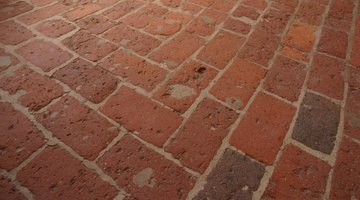Polyurethane on Brick Floors
Polyurethane makes a great sealant for brick floors. It's durable and gives the brick a beautiful shine. What’s more, polyurethane will increase the life of the brick because it provides an added layer of protection against wear and tear.

If you decide to coat your brick floors with polyurethane, the most important part of the job is preparation. The keys to a successful outcome are getting the brick as clean as possible, letting it dry completely after cleaning, and applying the polyurethane smoothly.
Clear the Room
Clear the room of all furniture and debris. Mask off anything attached to the floor that can't be moved, as well as baseboards. Use wide masking tape since polyurethane is difficult to clean off after you're done.
Clean the Brick
If you’re refurbishing older bricks that are already painted or coated in polyurethane, you'll need to strip the bricks with paint and varnish remover. Just be sure to work with lots of ventilation, and take frequent breaks. You'll need stiff metallic brushes and rags. When finished, wash the bricks with mineral spirits. Once the bricks dry, clean them with phosphoric acid. This will help remove any leftover residue and condition the surface of the bricks so the polyurethane adheres properly. Allow bricks to dry completely. If you're sealing new bricks or bricks that have never been coated, wash them with phosphoric acid.
Polyurethane Choices
Purchase polyurethane specially designed for masonry or concrete. You'll have a choice of finishes, so select one that suits your decor and tastes. Before putting down the polyurethane, you might want to consider using concrete stain to color the bricks. Again, this is a personal choice and not required. If you're uncertain about how your brick will look with polyurethane on it or want to see how concrete stain will look, find an inconspicuous spot and test a small portion.
Applying the Polyurethane
Fill a sturdy paint tray with the polyurethane. Working with a standard paint roller and extension handle, begin coating the brick, starting in a corner of the room away from the exit doorway. Use long, parallel strips, and apply the sealant evenly as you work. Overlap each strip. The odor given off by polyurethane bothers some people. You might consider wearing a mask. At the very least, whether you’re bothered by the odor or not, plan on taking frequent fresh air breaks. Let the polyurethane dry for 48 hours before moving furniture back.
The Drip Cap
- Polyurethane makes a great sealant for brick floors.
- Mask off anything attached to the floor that can't be moved, as well as baseboards.
- If you’re refurbishing older bricks that are already painted or coated in polyurethane, you'll need to strip the bricks with paint and varnish remover.
- Just be sure to work with lots of ventilation, and take frequent breaks.
- Allow bricks to dry completely.
Writer Bio
Matt Smolsky has been writing for more than 25 years. He wrote news, sports and feature stories for the "Omaha World-Herald" and other publications and has continued on in direct marketing and general advertising. He now writes for the web as well. He holds a Bachelor of Arts in history and journalism from the University of Nebraska-Omaha.
Photo Credits
- Hemera Technologies/AbleStock.com/Getty Images
- Hemera Technologies/AbleStock.com/Getty Images
More Articles



